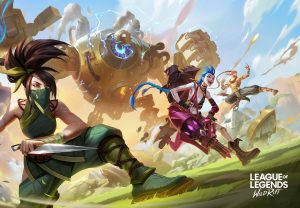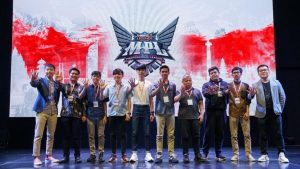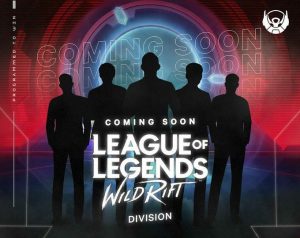Riot Games’ League of Legends is one of gaming’s most popular IPs and its arrival on the mobile platform, via Wild Rift, has been met with great enthusiasm from the community.
Although the title is still in beta and available in limited regions, many have labelled Wild Rift as the title that could very well change the mobile esports landscape. Riot’s past experience in creating successful esports IPs also means that organisations and players are already looking at the title from a competitive standpoint.

The popularity of mobile gaming in Southeast Asia along with its affinity to MOBA titles makes it an important region for Riot to tackle. While the League of Legends IP is held by Garena in the region, with Wild Rift, Riot has the ability to create a large and passionate community. The company is already beginning to realise the importance of markets like Southeast Asia, having recently launched a host of new initiatives and plans for gamers in the region.
SEA, MOBA and mobile gaming – A potent combination
It’s no secret that mobile gaming is absolutely massive in Southeast Asia, much more so than anywhere else in the world. Southeast Asia is a very important region for four major mobile titles – Free Fire, Mobile Legends: Bang Bang, PUBG Mobile, and Arena of Valor. The popularity of mobile titles in the region has led to local organisations such as EVOS Esports, RRQ, and Bigetron all going from local names to securing funding and setting up large scale operations in the region. Titles such as PUBG Mobile, which have a comprehensive seasonal structure, attracted the likes of Team Secret and Faze Clan into the region while also helping local organisations expand their operations.
SEA is also the only region globally where mobile MOBA titles such as MLBB and AoV have done well. Both titles have their own ecosystem which has seen high degrees of success. The MPL or Mobile Legends Professional League is the bread and butter of the MLBB esports ecosystem and follows the LEC/LCS model. In 2019, the cost of buying a franchise slot in MPL-Indonesia was $1M(760K GBP). The MPL concluded its sixth season in October 2020 with plans to host Season 7. Vietnam is an especially important region when it comes to Arena of Valor and has single-handedly kept the title in contention with the likes of MLBB.

The MOBA genre has always done well in SEA, even when it comes to tier-one titles such as League of Legends and Dota 2. In comparison, the region isn’t as noted for its achievements in the FPS genre. To sum things up, SEA represents a region where the MOBA category is already tried and tested, mobile gaming operates at a much much higher scale than traditional PC and console titles and the esports infrastructure already exists at all levels of competition.
Riot and SEA – The battle to regain lost ground
Riot’s operations in SEA have been limited up until recent years. This was mostly because they sold the rights to their only title – League of Legends to Garena and had little reason to operate in the region. The release of VALORANT saw Riot partner with organisers across various SEA countries to roll out a comprehensive plan for the title’s esports structure for 2021. The California based developer has already made it clear that they want to engage with the community directly and would not be interested in selling the publishing rights to any of their other titles. With Riot directly in charge of Wild Rift, the opportunities can be endless and if they are to go the League route with their esports ecosystem, SEA would be the ideal place to start.
The potential of Wild Rift hasn’t gone unnoticed in SEA, where stakeholders are very much aware of how big IPs like the LEC and the LCS are. Hong Kong-based Nova Esports and Indonesian organisation, Bigetron have already announced plans to acquire rosters in the title. In India, North American organisation, Noble Esports has already announced a full squad despite the game not being launched in the region.
The unbanning of PUBG Mobile and the announcement of Krafton’s $100m (~£75.91m) investment into India is also great for any esports title because now the country has the attention of local and foreign investors as well as sponsors. As organisations rush to find place and relevance in the country’s PUBG Mobile ecosystem, their natural expansion will be into Wild Rift, which is in line with the country’s mobile-first audience and player base.

Edging out the competition
Wild Rift’s primary contenders in SEA are Mobile Legends and Arena of Valor. While Arena of Valor has seen a decrease in both viewership and popularity in recent months, MLBB is the go-to mobile MOBA in the region with a strong presence across multiple countries. However, both titles are limited to SEA and have a very minimal presence anywhere else in the world. Wild Rift on the other hand is positioned as a global IP with a strong brand presence. While the entry barrier to MOBAs is relatively higher than that of FPS games, the success of the League of Legends franchise makes it a lot more familiar and easy to get into.
Wild Rift is still in its beta phase and hasn’t seen a worldwide release. Despite this, the buzz around the title has been massive and reactions to the game have largely been positive. SEA is fertile ground for a title like Wild Rift to prosper with pre-existing infrastructure, a growing player base and an engaged audience. But unlocking the potential of the region requires a good understanding of the local market and will require Riot to be more hands-on in the region.
This story is written in collaboration with AFK Gaming. AFK is an India-based esports media and content company that aims to provide quality and consistent coverage about teams, players, tournaments and competitive video games with a primary focus on the Asian region.
